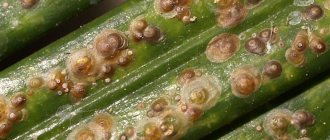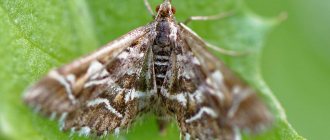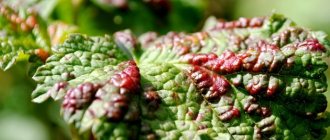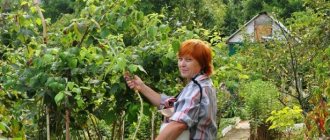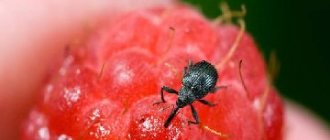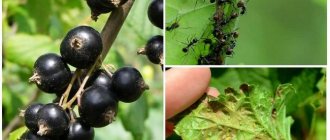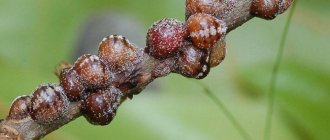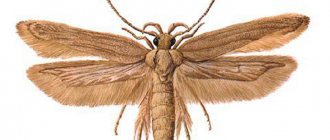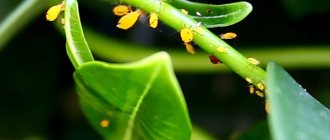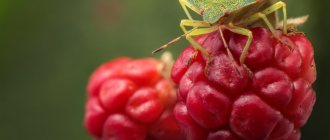Description of the pest
Scale insects are insect pests of the hemiptera family of the scale insects superfamily. More than 2000 species are known, and the most dangerous for apple trees are:
apple scale;- Californian scale insect.
Both types of pests have common features:
- The female scale insect reaches sexual maturity already in the larval stage and has no limbs, eyes or antennae. Developed organs - genitals.
- Leads a sedentary lifestyle.
- It is characterized by sexual dimorphism - it has significant anatomical differences between females and males.
- The shield is quite easily separated from the body by mechanical action.
- Females and larvae of scale insects have piercing-type oral bristles, with the help of which they pierce the bark and stick to its surface.
- By feeding on the sap of an apple tree, the insect damages the cambium - the educational tissue that ensures the growth and development of the tree.
- A colony of scale insects leads to the death of young shoots within 20–30 days, and within a season it can completely destroy an adult tree.
Description
Scale insects can attack both indoor and garden plants. What do scale insects look like? Their bodies are covered with a dense protective shell, consisting of two or one skin and secretory wax. The shield is easily separated from the insect. The mouthparts of the scale insect are sucking. The types of pests differ from each other in color, size and taste preferences. The danger of insects of this family is that their larvae, almost immediately after emerging from the eggs, settle in the ground organs of the plant and begin to suck the juices from them. The leaf blades can be completely covered with shields.
Scale insect larvae attach to the shoots, trunks and undersides of plant leaves and feed on cell sap. With strong occupation, the leaves seem to become covered with a coating of scale insects, prematurely turn yellow and fall off, the shoots dry out, and as a result, the growth and development of the plant slows down.
On indoor flowers, scale insects and their larvae function all year round. These insects reproduce very quickly. Most members of the family reproduce by laying eggs, but there are also viviparous species. At the initial stage, scale insect larvae are very mobile, especially the male flying ones, which easily spread to neighboring plants. However, males live for several days, while females are able to reproduce and damage flowers for several months.
- How to remove flower midges
During their life, scale insects secrete honeydew - a sticky substance on which a sooty fungus settles, and this does not add health to the plants.
It must be said that scale insects are often confused with false scale insects - arthropod insects belonging to the same order, but classified into a special family that unites more than a thousand species. Scale insects and false scale insects differ in that the latter do not have a waxy shell: their eggs and larvae are protected by the dry skin of females that die after laying.
How to determine that a plant is affected by scale insects? At an early stage of development, scale insects move very quickly, and pests can only be detected through a magnifying glass. If you see rounded light or brown scales in those places where the leaf cuttings are adjacent to a branch or trunk, then you can be sure that these are adult scale insects. If you were unable to detect the appearance of these pests in time, then as their population increases, a sticky liquid - honeydew - will begin to flow from the plant onto the windowsill, and here you should have no doubt that the plant is affected by scale insects.
Apple scale
Distributed throughout all areas of the apple growing zone. The appearance is shaped like a comma.
Main characteristics of the female pest:
- body – 0.7–1.8 mm, milky white, pear-shaped;
- the scutellum is dense, dark brown in color or in accordance with the color of the tree bark, up to 4 mm long, consists of one larval skin;
- pygidium - posterior rounded section of the abdomen, expanded relative to the anterior part, includes the anus and ovipositor;
- development begins at ambient temperature +6…+8 °C;
- fertility – 70–100 eggs per season;
- number of generations per year – 1;
- egg – 0.1 × 0.3 mm, oval in shape, white, as it matures (within 8–10 months) it acquires a beige tint;
- the size of a three-day larva is 0.3–0.5 mm;
- larval maturation period is 30–50 days;
- lifespan – up to 90 days.
The male apple scale is characterized by the following indicators:
- the body is elongated, up to 0.5–0.8 mm long, divided into a head, chest and rounded abdomen;
- scutellum – dense, light brown, pale orange or red-gray, up to 0.8 mm long;
- has wings and is able to move up to 20 m;
- no oral apparatus;
- Life span is up to 24 hours, dies immediately after mating.
Stages and terms of development
First instar larva (vagrant)
The appearance of larvae occurs in early spring when a stable temperature reaches +8...+10 °C. The mass birth coincides with the beginning of apple tree flowering and lasts for 7–14 days.
Main characteristics:
- flat oval body shape;
- antennae and eyes are well developed, there are three pairs of legs;
- color – from pale yellow to light brown;
- length – up to 0.3 mm.
Within 24 hours after hatching from the eggs, the larvae crawl along the tree trunk, and they do this independently or through phoresy - dispersal with the help of other insects, such as ants.
Phoresia leads to extensive infestation of an orchard with scale insects within 2–5 days.
Fixing itself with its mouth proboscis on the trunk or young shoot of an apple tree, the tramp becomes covered with a thin waxy coating and loses mobility. After 12–18 days, the plaque cracks in the lower part, and the larva enters the second stage of development.
The development of the first stage goes completely unnoticed!
Second instar larva
The larva of the second stage of development becomes overgrown with a shield consisting of the remains of a waxy coating of the first stage of development and its own secretory secretions, containing biologically active substances and promoting the development of the female. The size of the scute increases as the larva grows.
Main characteristics:
- body length – 0.3–0.6 mm;
- shape – elongated, close to the shape of a comma;
- eyes, antennae and legs are absent;
- The color of the larva is dirty white, the posterior abdominal region is brown.
The duration of the second stage of development is 20–30 days, after which the larva turns into a female apple scale insect.
From the moment the first larva appears until sexually mature females populate the tree, 40–50 days pass.
Female
The female scale insect actively feeds on tree sap. Within 18–22 days it becomes overgrown with an impenetrable hard shield up to 4 mm in size, which takes on a pronounced comma shape. The pest's body increases in size and fills the entire space under the shield. Typically this stage of development occurs in July.
At the beginning of August, the female begins to lay fertilized eggs under the shell, while her body shrinks, giving way to the clutch, and occupies only a small volume in the front part. Having completed the process, the female dies.
Within 45–60 days, each individual lays up to 100 eggs under its shell.
Eggs
The eggs of the pest overwinter on the bark of the apple tree under the shield. They are frost-resistant and can withstand ambient temperatures down to -40 °C. In the spring, when warm weather sets in, the process of hatching of the larvae begins.
Questions from gardeners about the fight against scale insects
Question No. 1. What air humidity should be around the plants to prevent scale insects from infesting them?
Question No. 2. What to do if the chemical did not work and did not kill the scale insect?
The disadvantage of chemical insecticides is that over time, insects develop immunity to the active substances. Therefore, it is recommended to alternate drugs, making sure that the active substance is different. Another reason for this situation is that the product is not suitable for combating scale insects. When choosing insecticides, you must carefully read the instructions.
Question No. 3. Is it possible to use insecticides not for spraying plants, but for watering?
It is possible if these are systemic drugs. The products of this group, with a solution absorbed by the roots, are distributed throughout all parts of the plant and act on pests from the inside. These include, for example, “Aktara”, “Konfidor”, “Commander”. Contact preparations are not suitable for irrigation. They are effective only when directly affecting the body of insects.
Question No. 4. If scale insects do not move on the leaves, can we assume that they are dead?
It is forbidden. Adult female scale insects do not crawl. They sit motionless and guard their offspring, which are so small that they can only be seen under magnification. We can consider that the fight against scale insects has been successful only if the pests do not appear again within several months.
Question No. 5. What indoor plants do not grow scale insects?
Unfortunately, there are no such plants. Scale insects can attack any indoor flowers if they are suitable for them in terms of species. For example, the orange scale insect will not settle on a cactus or aloe, and the cactus scale will not settle on lemon or dracaena.
Rate the quality of the article. We want to be better for you:
Scale insects, as well as false scale insects, are a harmful insect that can infect various plants. It poses a danger to a huge number of indoor plants. But laurel, citrus fruits, oleadra, palm trees, and amaryllis can especially suffer from it.
Scale insects (Diaspididae) are representatives of the family of homoptera insects of the suborder Coccidae. Their body has a round shape. And it is noteworthy that females have coverings on the top of their bodies in the form of wax shields.
The false scale insect is a representative of a different family (Coccidae or Lecaniidae), but belongs to the same order of coccids. Their size is much larger than that of scale insects, more precisely, from 3 to 7 millimeters. These insects do not have a shield, and the eggs and larvae are protected by the dried body of the female.
In both false scale insects and scale insects, the difference between females and males is quite large. Once the female becomes an adult, she stops moving, thus protecting the eggs attached to the surface of the plant. Males, which are not very large in size, on the contrary, are quite mobile. At first, the larvae are also very mobile, but when they join the plant, they become motionless and a waxy shield appears.
Californian scale
In Russia, Californian scale is widespread in the southern regions, Crimea, the Caucasus and the Far East. Included in the list of quarantine objects - the import of planting material from the pest's habitat areas is prohibited.
Causes harm to fruit and ornamental trees and shrubs of various types and varieties. More than 250 plant species are included in the list of possible damage.
Main characteristics of the female pest:
- refers to a viviparous species of insects;
- fertility – 120–200 mobile larvae per generation;
- number of generations per year – 2–4;
- The development period of each generation is 58–62 days;
- body – 2.8–3.5 mm, bright yellow, round in shape;
- the shield is dense, dark brown in color or in accordance with the color of the tree bark, with a white edging, up to 5 mm in diameter, consists of two larval skins;
- in the center of the shield there are two light brown or pale orange stripes;
- lifespan – up to 180 days.
The male is characterized by the following indicators:
- body – oval, up to 0.9 mm long, divided into head, chest and rounded abdomen;
- shield – dense, light gray, gray or black, up to 1 mm long;
- often has wings and is able to move up to 30 m, but wingless individuals are also found;
- antennae, three pairs of legs and eyes are well developed;
- no oral apparatus;
- lifespan – up to 48 hours.
Stages and terms of development
First instar larva (vagrant)
Mass development of overwintered larvae occurs in early spring with the beginning of sap flow. The development of males and females during this period is no different.
Main characteristics:
- flat oblong oval body shape;
- antennae and eyes are well developed, there are three pairs of legs;
- the oral apparatus is 2–3 times longer than the body and is 0.5–0.9 mm;
- color – from pale yellow to light orange;
- length – up to 0.3 mm.
Within a few hours after waking up, the larvae crawl along the tree trunk on their own or with the help of other insects.
They can live without feeding for 5–7 days, but are attached with their oral proboscis to the trunk or skeletal branches within 1–2 hours after development.
Colonies of the Californian scale insect, as a rule, do not settle on young shoots. In rare cases, they settle in cracks in the bark or near fruit buds.
As the larva begins to feed, it secretes waxy threads that transform into a white scutellum and cover the body. Within 7–10 days, the wax shield darkens and acquires an off-white or gray tint. Molting begins, which lasts another 10–12 days - by this time the development of the first instar ends.
Second instar larva
The second stage of larval development begins 20–22 days after the start of development.
Main characteristics:
- diameter of the round body – 0.4–0.6 mm;
- eyes, antennae and legs are missing;
- the color of the larva is lemon yellow;
- Shield color: grey.
The duration of the second stage of development is 30–35 days, after which the larva turns into a female Californian scale insect.
Female
The maturation of the female coincides with the development of sexual maturity of the males. Over the next 20–30 days, the insect mates, and reproduction often occurs through parthenogenesis - without fertilization.
The hatching of new larvae lasts for 45–60 days.
Colonies of the Californian scale insect at the end of apple tree fruiting consist of individuals of different ages. When the temperature drops to -15...-20 °C, the second instar larvae and females die. First instar larvae overwinter under the shield at temperatures down to -35 °C.
Struggle
Pest control begins with its mechanical removal. If there are false scale insects on indoor flowers or small plants, insects and larvae can be removed with a damp sponge or cloths. On tree shoots they are scraped off with the blunt side of a knife. Large spruces and thujas are also doused with water from a hose under high pressure. But such a measure, of course, will not be enough. Therefore, modern insecticides and folk remedies that have already been tested by time are used.
Chemicals
Several treatments may be needed to resolve the problem. Trees and shrubs are usually sprayed twice a year: at the time the leaves emerge from the buds and in early July, when the larvae spread en masse along the branches. If necessary, the treatment is repeated in accordance with the instructions for the drug. At home, 2–4 procedures are usually required at 10–14 day intervals: pests must be completely destroyed. Insecticides are effective against false scale insects:
- Systemic impact: “Aktara”, “BI-58”, “Confidor”.
- Organophosphorus preparations, such as Actellik, Karbofos, Phosbecid.
- Can also be used: “Arrivo”, “Bankol”, “Calypso”, “Fitoverm”.
You should treat not only the infected plant, but also your neighbors, window sill, and window frame. They replace the top layer of soil, in which individual eggs and larvae of false scale insects could hide.
Folk remedies
Measures to combat false scale insects include the use of folk remedies. This:
- Alcohol (or vodka) is used to wipe leaves and shoots.
- Soap solution: 15 g of liquid soap or a handful of grated shavings are diluted in 1 liter of water at a temperature above room temperature. To increase efficiency, 10 ml of alcohol can be added to the composition, but this is undesirable when treating plants with delicate foliage.
- Soap and kerosene solution: 40 g of laundry soap are diluted in 1 liter of water, add 5 drops of kerosene. The liquid is thoroughly mixed until smooth.
- Soap and oil solution: has a similar recipe, only instead of kerosene they take 100 ml of machine oil. Plants must be cleared of this composition after 8 folk remedies, 8–12 hours after treatment.
- Garlic infusion: a few cloves are infused for 12 hours in a liter of water.
Folk remedies are less aggressive for false scale insects than chemicals. Therefore, they can be used only for small-scale infections and with regular use.
The false scale insect, like the true scale insect, parasitizes many types of plants. The ability to quickly reproduce rapidly increases the number of parasites, drawing juices from the victim. You can stop the pest by using chemicals or folk remedies. A combination of control methods will achieve a positive result.
Damage caused
The scale covers the trunk and shoots of the apple tree with a continuous layer. Infected trees:
- are significantly delayed in development;
- do not produce new shoots;
- do not bear fruit or produce a small harvest of low-quality apples - small and tasteless;
- the frost resistance of the apple tree decreases;
- immunity to fungal or viral diseases decreases or disappears;
- the risk of developing black cancer increases tenfold.
Without pest control, the tree dies within 1–2 years.
How to identify a pest
On the bark of a tree or bush infested with scale insects, curved, comma-shaped gray-brown scutes are visible (takes on the shade of the bark of the affected tree), maximum 4 mm long. The scutes cover the female or eggs of the insect. When a tree or bush is heavily infested, the bark is almost completely covered with scale insects, the plant quickly loses vigor, the bark dies and the leaves fall off, young branches stop growing, and the tree becomes frost-resistant and prone to infection by other pests; fruit buds are not formed. A distinctive feature of the apple comma scale insect on the fruit is that small red spots are clearly visible.
The insect mostly prefers apple trees, however, it can also be found on pear, plum, currant, peach, cherry plum and mulberry. It often affects rowan or hawthorn. Less often it settles on walnut or dogwood.
Signs of scale insects
The main signs of the presence of a pest:
- Sticky juice appears on the leaves - a waste product of the scale insect, in which black rot begins to develop within 12-24 hours. At this stage, the pest's shield is not yet fully formed - it is necessary to begin spraying with chemicals.
- Tightly attached pests appear on the trunk, skeletal branches and shoots. At this stage, the damage is already quite strong; to get rid of it, it is necessary to apply a set of measures.
One of the signs of damage to an apple tree by the Californian scale insect is the presence of individual or multiple bright red spots on the fruit.
Comma-shaped scale insect on an apple tree - how to fight and prevent the pest from spreading too much
- If a pest is identified, preventive measures should be taken: thin out the tree crowns, trim the affected branches; if the pest has managed to destroy any tree or bush, they also need to be removed. All remains must be burned.
- Before planting any tree or bush, you should carefully inspect it; only healthy trees should be planted.
- Seven-spotted ladybugs are a natural enemy of scale insects, so you need to create all the conditions for their spread in the area.
- Colonies of scale insects, moss, lichen and dead bark must be removed from all skeletal branches and trunks. Collect everything (you can immediately lay it down with paper) and burn it.
- If the foci of scale insects are small, they can be washed off. To do this, add garlic and tobacco to the water, and wash off the colonies of parasites from the branches. The cleaning procedure is repeated several times.
For more hardworking summer residents, we present the simplest composition of the mixture for washing off the parasite. The amount of each ingredient is calculated for 10 liters of water:
- Laundry soap – 100 g;
- Green soap – 50 ml;
- Soda (soda ash) – 50 g.
The method is labor-intensive and does not give a 100% result, because cleaning is convenient only at low altitudes and on hard-leaved plants, and scale insects located in the foliage and cracks in the bark will still remain. This method can only get rid of 50% of the pest. But as they say, patience and work will wash away, grind and grind everything...
- In order not to harm the garden, fruits and beneficial insects with chemicals, affected trees and bushes can be sprayed with biological preparations, for example Fitoverm, or select others. The best period for spraying is from late June to early July.
- You can also add Fitoverm to the clay, dilute the mixture to the consistency of sour cream and whiten the infected skeletal branches. This whitewash needs to be updated occasionally, as rain washes the putty off the top of the branches.
You need to keep an eye on the garden - this is the only way to guarantee getting rid of the scale insect. Timely pruning and removal of dry branches, trees and bushes will reduce the risk of pest infection, and a properly selected garden sprayer will help not only get rid of unwanted guests, but also preserve beneficial insects. We hope that the proposed environmental methods for dealing with scale insects on apple trees will be useful to you.
Apple tree varieties resistant to scale insects
The following varieties are immune to damage from the Californian scale insect:
- Rosavka;
- Sapphire;
- Kiev winter;
- Antonovka vulgare;
- Simirenkovets.
No varieties have been developed that are resistant to apple scale, but it has been noted that young trees have stronger immunity.
Timely implementation of preventive measures increases sustainability.
Preventive measures
It is difficult to combat scale insects due to their high reproduction rate. It is much easier to prevent their appearance on plants. Preventive measures to get rid of them include the following:
- The plant must be inspected every two weeks for parasites. This is done during feeding, replanting or wiping dust from the leaves. The process will not take much time.
- Each plant must live in favorable conditions: climate, watering, sunlight. If these conditions are not met, the plant becomes weakened and more susceptible to insect attack.
- If we are talking about a house plant, you need to make sure that the saucer under the flower is empty. After watering, it drinks water after 4 hours, the remainder must be removed.
- During watering, the plant needs to be fed with vitamins and minerals. Then its immunity will be strong, and it will be able to resist parasites.
- Plant roots should not be infringed. If the pot is small, the flower should be transplanted into a larger container.
These simple steps will help you avoid the difficult fight against scale insects. Their immunity depends on caring for plants.
Scale insects are the most dangerous parasite that not only harms the plant, but also kills it. A problem detected in time can prevent a number of unpleasant actions. The plant is not able to speak, so it shows danger through its appearance. With proper care, trees and flowers will delight people for many years.
Pest control methods
It is very difficult to destroy colonies of scale insects due to the presence of a dense shell - the pests are absolutely resistant to spraying with insecticides. The fight must be waged using a combination of different methods.
Mechanical method
The mechanical way to get rid of scale insects is as follows:
- Cleaning the trunk, branches and shoots affected by scale insects with a metal brush. At the same time, it is important to avoid damaging the tree bark - fungal diseases quickly arise and develop in the affected areas.
- Removal of branches significantly affected by the pest. This is done with a sharp knife or pruning shears. When pruning with a hacksaw, be sure to trim the edges of the wound and cover it with garden varnish.
Collected waste, damaged or affected parts of the plant must be destroyed by burning.
Once the treatment is complete, you should begin combating with chemicals.
Fighting with chemicals
Chemical control is the most effective way to get rid of scale insects. In this case, it is important to treat the affected plant throughout the season with recommended preparations in compliance with the deadlines:
- Spring processing. It begins in early spring when the average temperature reaches +5...+7 °C, which corresponds to the beginning of the development of first-instar larvae that do not have a hard coating. The apple tree and trunk circle are sprayed with one of the following preparations:
- Aktara is a paralytic poison. Penetrates into leaf tissue, and, together with tree sap, into the oral cavity of the scale insect, which dies within 2–24 hours.
- Actellik – has a high speed of action. Instantly penetrates upon contact with a larva unprotected by the shield and paralyzes the nervous system, which leads to its inevitable death within 12–36 hours. Not active against eggs and female scale insects.
- Fitoverm is a biological preparation. Within 6–12 hours it causes paralysis of the larvae and leads to death within 24–36 hours.
- Bitoxibacillin is a biological insecticide with intestinal action. Leads to the death of the first term larvae within 12–36 hours.
Repeated treatment of first instar larvae is carried out 7–10 days after the first.
- Subsequent treatments (up to 5 times per season) with biological preparations “Fitoferm” and “Bitoxibacilli” are carried out only in the absence of females in order to completely destroy the pest and prevent its appearance.
- Summer treatment with chemicals is carried out in case of untimely, and therefore ineffective, spring spraying. This treatment includes root watering of the apple tree with preparations diluted according to the attached instructions:
- Aktara;
- Phosphamide.
Watering is carried out at the rate of 10–15 liters of solution per tree 2–3 m high. In this case, the poison penetrates through the root system into all tissues of the apple tree and, together with the juice, into the oral cavity of the female scale insect, which dies within 6–12 hours.
After 12–24 hours, the tree must be sprayed with Actellik, Fitoverm or Aktara.
Before the end of the season, the apple tree should be watered in a timely manner in order to remove toxins, while it is important to monitor the rate of water consumption and avoid excessive moisture - the treated tree is poorly resistant to fungal diseases.
Root treatment is the most effective way to instantly get rid of scale insects. However, with this method you will have to destroy the entire crop.
Fruits obtained from a tree after the application of root insecticides are strictly prohibited from being used as food, including after heat treatment! They are full of poison! Their use will lead to serious damage to the human body!
- Autumn treatment involves preventive spraying with biological preparations.
Agrotechnical measures
They are carried out for the purposes of prevention, protection and as part of a set of measures to combat the pest. Are as follows:
- timely pruning and crown formation;
- removal of dry branches damaged by fungal diseases;
- maintaining optimal distances when planting fruit trees;
- timely destruction of weeds from the tree trunk and root shoots;
- destruction of anthills;
- timely fertilization of the apple tree with mineral additives in order to increase resistance to pest damage;
- carrying out mandatory spring and autumn preventive measures.
Prevention of damage to apple trees by scale insects using traditional methods
As preventive measures it is recommended to use:
- Spraying or hand washing the tree with a soapy solution in the spring before sap begins to flow and after flowering ends. To prepare the product, you need to thoroughly stir 150 g of laundry soap and dissolve it in 10 liters of warm water. Apply in the early morning or after sunset. Provides protection against diseases and prevents pests from gaining a foothold on the trunk or leaves.
- Spraying the tree and pouring the soil with an infusion of onion peels prepared according to the recipe: brew 3-5 dense handfuls in 5-7 liters of boiling water, leave for 3-5 hours. Increases resistance to diseases and prevents pest infestation.
Destruction of scale insects using traditional methods of treatment does not bring results! Scale insects are a strong and persistent pest! You can only get rid of it with aggressive chemical action!
How to get rid
When destroying scale insects, it is important to remember: a dense shell protects the insect from the penetration of pesticides, so ordinary spraying will help little.
- To increase effectiveness, you must wipe each plant by hand, removing non-motile adult insects that may lay new eggs. But all compositions quickly infect clutches and voracious larvae, simultaneously protecting plants from new infection.
- It is recommended to cut off the affected branches of trees and shrubs after laying plastic film on the ground. All cut parts are immediately burned, the branches are wiped with a soap solution or diluted insecticide.
- Remove attached adult insects from garden plants and flowers using a damp cloth or brush. Then the plantings are sprayed with an insecticide diluted in accordance with the instructions. The treatment is repeated at least 3 times to get rid of newly hatching insects.
Preventive measures
To prevent infection of the garden, you need to carefully inspect each purchased plant. You can quarantine new seedlings for a while. This rule also applies to self-grown seedlings. It is easier to get rid of scale insects on 2-3 plants than to treat the entire greenhouse later.
If scale insects are found on plants in pots (including garden ones), they need to be isolated as much as possible to prevent infection of healthy specimens.
Expert opinion
Mityuk Stefania Bogdanovna
Timely weeding of the beds and mowing the grass between the rows and on the lawns will help to protect the plantings. Weeds affected by scale insects should not be thrown into the compost: they must be burned.
The scale loves heat and moisture and does not tolerate direct sunlight. To prevent infection, it is recommended not to thicken the plantings, remove weeds in a timely manner, and mulch the soil.
It is important not to overdo it with watering. Particular attention should be paid to greenhouse plants: it is recommended to spray them with a weak solution of a bio-insecticide even before pests are detected. Greenhouses must be ventilated after each watering, ensuring normal air circulation.
Folk recipes
Folk recipes offer compositions for wiping affected plants.
They help quite well in the initial stages of infection and in small, confined areas. To achieve the desired effect, you need to wipe the plants 3 times a week. Spraying will not help: a hard shield prevents substances from penetrating the body of an adult insect, and traditional methods have almost no effect on larvae and eggs.
Compositions prepared according to folk recipes can be used to combat scale insects on garden and indoor flowers, and vegetable crops. Soap solutions help destroy adult parasites on fruit trees.
Experienced gardeners recommend the following recipes:
- Mix 100 ml of milk (not skimmed) with 1 liter of water, add 0.5 bottles of alcohol tincture of iodine. Wipe the affected plants with the liquid, paying special attention to the stems and lower parts of the leaves.
- Grind 50 g of hot pepper pods, add 0.5 liters of water, bring to a boil and cook for 5 minutes. Remove from heat and add boiling water so that the total volume is 1 liter. Leave covered for a day, strain, and store in the refrigerator. Before use, dilute 10 ml of infusion in 1 liter of water, add 30 g of grated laundry soap. Wipe the affected plants until the scale insects are completely destroyed.
- Several small onions are chopped, pour 5 liters of boiling water and leave for 5-6 hours. After straining, the liquid is used to wipe the leaves and stems. For greater effectiveness, add a little grated laundry, tar or boric soap to the infusion.
Experts do not recommend using oil-based formulations. They cover the leaves with a thin film and block the access of oxygen. After several treatments, the plant may die. Compositions containing alcohol are no less dangerous. They are allowed to be used for wiping the walls of greenhouses, but when applied to stems and leaves, alcohol-containing liquids can cause burns.
Do you take preventive measures against scale insects?
Of course not
Chemicals
In case of extensive lesions, complex insecticides will help cope with scale insects. For the vegetable garden, it is better to choose safe, low-toxic preparations marked “4” or “3” on the packaging. These products do not accumulate in the soil and are safe for birds, bees, and pets. Both seedlings and adult plants can be treated no later than 3 days before harvest.
Before processing, plantings need to be watered well. Work is carried out with rubber gloves, the mouth and nose are protected with a mask or respirator. Particular care must be taken in greenhouses: after processing they must be ventilated.
Gardeners recommend the following effective formulations:
"30 Plus"
A safe and effective drug against leaf-sucking insects. Recommended for washing and spraying fruit trees and shrubs, but can also be used in greenhouses. It is better to treat plants in spring and early summer, before the flowering period. The drug destroys egg clutches, larvae and adult insects, protects plantings for 20 days. Double processing is recommended.
"Aktara"
A very effective drug, necessary for severe infections. Quickly destroys scale insects, aphids, whiteflies and other pests. The main active substance is thiamethoxam. The drug is absorbed into the leaves, but does not penetrate into the fruits. Protects plants for 20-25 days, resistant to sun and precipitation. Suitable for processing berries, vegetables, fruit trees, indoor and garden flowers.
"Admiral"
The best drug for the Californian scale insect, which attacks fruit trees and shrubs, tomatoes, and cucumbers. It has a delayed effect and protects plants for at least 20 days. Can be used in greenhouses and greenhouses. Acts on larvae and adult insects, destroys masonry. Treatment is carried out at least 2 times, with a break of 2 weeks.
"Bitoxibacillin"
A preparation from a series of bio-insecticides, prepared on the basis of a strain of beneficial bacteria. Safe for animals and people; repeated processing is required. Combines well with other drugs. Can be used to process any crops at temperatures above 18 degrees.
"Aktellik"
A potent remedy used for severe lesions. Effective against all types of scale insects, whiteflies, aphids, and Colorado potato beetles. The active ingredient is perimiphos-methyl. It acts complexly, penetrating through the body of insects and entering the digestive system. Quickly destroys adult parasites and larvae, but does not affect eggs. Suitable for processing any crops, preferably used during the growth period.
"Novaction"
A complex action insecticide that destroys all types of leaf-sucking and leaf-gnawing pests. Created on the basis of malathion, which has a paralyzing effect on parasites at all stages of development. Incompatible with some fertilizers and vegetable oils. Suitable for washing and spraying, the emulsion is pre-diluted with water.
Expert opinion
Mityuk Stefania Bogdanovna
It is recommended to alternate insecticides so as not to cause addiction to pests. Most drugs work well together, but you must read the instructions carefully before use.
